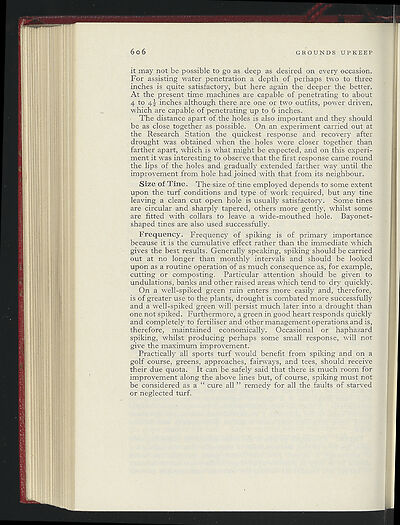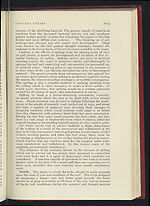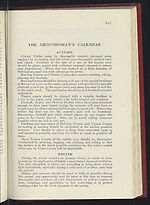1938-39
(640)
Download files
Complete book:
Individual page:
Thumbnail gallery: Grid view | List view

jl
i
4
6o6
GROUNDS UPKEEP
it may not be possible to go as deep as desired on every occasion.
For assisting water penetration a depth of perhaps two to three
inches is quite satisfactory, but here again the deeper the better.
At the present time machines are capable of penetrating to about
4 to
4ff'
inches although there are one or two outfits, power driven,
which are capable of penetrating up to 6 inches.
The distance apart of the holes is also important and they should
be as close together as possible. On an experiment carried out at
the Research Station the quickest response and recovery after
drought was obtained when the holes were closer together than
farther apart, which is what might be expected, and on this experi-
ment it was interesting to observe that the first response came round
the lips of the holes and gradually extended farther way until the
improvement from hole had joined with that from its neighbour.
Size of Tine.
The size of tine employed depends to some extent
upon the turf conditions and type of work required, but any tine
leaving a clean cut open hole is usually satisfactory. Some tines
are circular and sharply tapered, others more gently, whilst some
are fitted with collars to leave a wide-mouthed hole. Bayonet-
shaped tines are also used successfully.
Frequency. Frequency of spiking is of primary importance
because it is the cumulative effect rather than the immediate which
gives the best results. Generally speaking, spiking should be carried
out at no longer than monthly intervals and should be looked
upon as a routine operation of as much consequence as, for example,
cutting or composting. Particular attention should be given to
undulations, banks and other raised areas which tend to dry quickly.
On a well-spiked green rain enters more easily and, therefore,
is of greater use to the plants, drought is combated more successfully
and a well-spiked green will persist much later into a drought than
one not spiked. Furthermore, a green in good heart responds quickly
and completely to fertiliser and other management operations and is,
therefore, maintained economically. Occasional or haphazard
spiking, whilst producing perhaps some small response, will not
give the maximum improvement.
Practically all sports turf would benefit from spiking and on a
golf course, greens, approaches, fairways, and tees, should receive
their due quota. It can be safely said that there is much room for
improvement along the above lines but, of course, spiking must not
be considered as a " cure all " remedy for all the faults of starved
or neglected turf.
i
4
6o6
GROUNDS UPKEEP
it may not be possible to go as deep as desired on every occasion.
For assisting water penetration a depth of perhaps two to three
inches is quite satisfactory, but here again the deeper the better.
At the present time machines are capable of penetrating to about
4 to
4ff'
inches although there are one or two outfits, power driven,
which are capable of penetrating up to 6 inches.
The distance apart of the holes is also important and they should
be as close together as possible. On an experiment carried out at
the Research Station the quickest response and recovery after
drought was obtained when the holes were closer together than
farther apart, which is what might be expected, and on this experi-
ment it was interesting to observe that the first response came round
the lips of the holes and gradually extended farther way until the
improvement from hole had joined with that from its neighbour.
Size of Tine.
The size of tine employed depends to some extent
upon the turf conditions and type of work required, but any tine
leaving a clean cut open hole is usually satisfactory. Some tines
are circular and sharply tapered, others more gently, whilst some
are fitted with collars to leave a wide-mouthed hole. Bayonet-
shaped tines are also used successfully.
Frequency. Frequency of spiking is of primary importance
because it is the cumulative effect rather than the immediate which
gives the best results. Generally speaking, spiking should be carried
out at no longer than monthly intervals and should be looked
upon as a routine operation of as much consequence as, for example,
cutting or composting. Particular attention should be given to
undulations, banks and other raised areas which tend to dry quickly.
On a well-spiked green rain enters more easily and, therefore,
is of greater use to the plants, drought is combated more successfully
and a well-spiked green will persist much later into a drought than
one not spiked. Furthermore, a green in good heart responds quickly
and completely to fertiliser and other management operations and is,
therefore, maintained economically. Occasional or haphazard
spiking, whilst producing perhaps some small response, will not
give the maximum improvement.
Practically all sports turf would benefit from spiking and on a
golf course, greens, approaches, fairways, and tees, should receive
their due quota. It can be safely said that there is much room for
improvement along the above lines but, of course, spiking must not
be considered as a " cure all " remedy for all the faults of starved
or neglected turf.
Set display mode to:
![]() Universal Viewer |
Universal Viewer | ![]() Mirador |
Large image | Transcription
Mirador |
Large image | Transcription
| Games and sports in the army > 1938-39 > (640) |
|---|
| Permanent URL | https://digital.nls.uk/248744926 |
|---|
| Description | 'Games and Sports in the Army' was an annual publication produced by the British War Office between the 1930s and 1960s. This included the Second World War. It outlines the rules and regulations for games and sports played by members of the armed forces. It features names and photographs of team members, and examples of contemporary advertising. |
|---|---|
| Shelfmark | GWB.52 |

